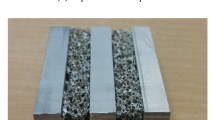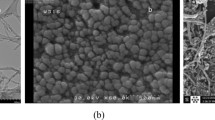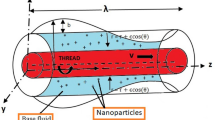Abstract
In the present work, the thermo-physical properties and hydraulic and thermal performances of alumina/water, silica/water, and alumina–silica/water nanofluids were experimentally investigated. The thermal conductivity and dynamic viscosity of nanofluids were measured for the volume fractions in the range of 0–2% and the temperature in the range of 10–40 °C. Some new correlations were proposed for the hybrid nanofluid. Single and hybrid nanofluids at the volume fractions of 0.05%, 0.1%, and 0.2% and the Reynolds number in the range of 490–3100 were tested in a mini-channel. Measurements of the thermo-physical properties indicated that the hybrid nanofluid provided larger values of the thermal conductivity and viscosity in comparison with the single ones. The results also showed that the Nusselt number increased with increasing the Reynolds number and volume fraction of the nanoparticles for all nanofluids. Hybrid nanofluid with 75% alumina–25% silica and volume fraction of 0.2% and the single alumina nanofluid with volume fraction of 0.2% provided the highest and the lowest increments in the Nusselt number with the mean increment values of 46% and 11%, respectively. The hydraulic performance assessment revealed that adding nanoparticles to the base fluid increased the friction factor in the mini-channel from 10.4 to 65.2% based on the values of the volume fraction. However, the thermal performance evaluation criteria are always above the unity regardless the type of the nanofluid and among the nanofluids considered in this study, and the maximum performance evaluation criterion was recorded for the hybrid nanofluid with the value of 1.23 at volume fraction of 0.2%.














Similar content being viewed by others
Abbreviations
- \(A_{\text{t}}\) :
-
Total heat transfer area \(\left( {{\text{m}}^{2} } \right)\)
- \(A_{\text{c}}\) :
-
Mini-channel cross section \(\left( {{\text{m}}^{2} } \right)\)
- \(c_{p}\) :
-
Specific heat capacity \(\left( {{\text{J}}\,{\text{kg}}^{ - 1} \,{\text{K}}^{ - 1} } \right)\)
- \(D_{\text{h}}\) :
-
Hydraulic diameter \(\left( {\text{m}} \right)\)
- \(h\) :
-
Convective heat transfer coefficient \(\left( {{\text{w}}\,{\text{m}}^{ - 2} \,{\text{K}}^{ - 1} } \right)\)
- \(H_{\text{ch}}\) :
-
Channel height \(\left( {\text{m}} \right)\)
- \(k\) :
-
Thermal conductivity \(\left( {{\text{w}}\,{\text{m}}^{ - 1} \,{\text{K}}^{ - 1} } \right)\)
- \(L_{\text{ch}}\) :
-
Channel length \(\left( {\text{m}} \right)\)
- \(\dot{m}\) :
-
Mass flow rate \(\left( {{\text{kg}}\,{\text{m}}^{ - 3} } \right)\)
- \(p\) :
-
Wetted perimeter \(\left( {\text{m}} \right)\)
- \(P\) :
-
Pressure \(\left( {\text{Pa}} \right)\)
- \(Q_{\text{conv}}\) :
-
Heat transfer rate \(\left( {\text{w}} \right)\)
- \(T\) :
-
Temperature \(\left( {\text{K}} \right)\)
- \(T_{\text{wi}}\) :
-
Wall temperature \(\left( {\text{K}} \right)\)
- \(u\) :
-
Velocity \(\left( {{\text{m}}\,{\text{s}}^{ - 1} } \right)\)
- \(W_{\text{ch}}\) :
-
Channel width \(\left( {\text{m}} \right)\)
- \({\text{avg}}\) :
-
Average
- \({\text{bf}}\) :
-
Base fluid
- \({\text{ch}}\) :
-
Channel
- \({\text{conv}}\) :
-
Convection
- \({\text{f}}\) :
-
Fluid
- \({\text{nf}}\) :
-
Nanofluid
- \({\text{h,nf}}\) :
-
Hybrid nanofluid
- \({\text{p}}\) :
-
Particle
- \({\text{in}}\) :
-
Inlet
- \({\text{out}}\) :
-
Outlet
- \({\text{rel}}\) :
-
Relative
- \(\mu\) :
-
Dynamic viscosity \(\left( {{\text{kg}}\,{\text{m}}^{ - 1} \,{\text{s}}^{ - 1} } \right)\)
- \(\rho\) :
-
Density \(\left( {{\text{kg}}\,{\text{m}}^{ - 3} } \right)\)
- \(\varphi\) :
-
Nanoparticle volume concentration
References
Maxwell JC. A treatise on electricity and magnetism. Oxford: Clarendon Press; 1881.
Choi SU. Enhancing conductivity of fluids with nanoparticles. ASME Fluid Eng Div. 1995;231:99–105.
Nguyen CT, Desgranges F, Galanis N, Roy G, Maré T, Boucher S, Mintsa HA. Viscosity data for Al2O3–water nanofluid—hysteresis: is heat transfer enhancement using nanofluids reliable? Int J Therm Sci. 2008;47(2):103–11.
Chandrasekar M, Suresh S, Bose AC. Experimental investigations and theoretical determination of thermal conductivity and viscosity of Al2O3/water nanofluid. Exp Thermal Fluid Sci. 2010;34(2):210–6.
Tavman I, Turgut A, Chirtoc M, Hadjov K, Fudym O, Tavman S. Experimental study on thermal conductivity and viscosity of water-based nanofluids. Heat Transf Res. 2010;41(3):209–21.
Said Z, Sajid MH, Alim MA, Saidur R, Rahim NA. Experimental investigation of the thermophysical properties of AL2O3-nanofluid and its effect on a flat plate solar collector. Int Commun Heat Mass Transf. 2013;1(48):99–107.
Arya A, Shahmiry S, Nikkhah V, Sarafraz MM. Cooling of high heat flux flat surface with nanofluid assisted convective loop: experimental assessment. Arch Mech Eng. 2017;64(4):519–31.
Salari E, Peyghambarzadeh SM, Sarafraz MM, Hormozi F, Nikkhah V. Thermal behavior of aqueous iron oxide nano-fluid as a coolant on a flat disc heater under the pool boiling condition. Heat Mass Transf. 2017;53(1):265–75.
Sarafraz MM, Arjomandi M. Demonstration of plausible application of gallium nano-suspension in microchannel solar thermal receiver: experimental assessment of thermo-hydraulic performance of microchannel. Int Commun Heat Mass Transf. 2018;31(94):39–46.
Sarafraz MM, Arjomandi M. Thermal performance analysis of a microchannel heat sink cooling with Copper Oxide-Indium (CuO/In) nano-suspensions at high-temperatures. Appl Therm Eng. 2018;5(137):700–9.
Sarafraz MM, Arya A, Nikkhah V, Hormozi F. Thermal performance and viscosity of biologically produced silver/coconut oil nanofluids. Chem Biochem Eng Q. 2017;30(4):489–500.
Sarafraz MM, Arya H, Arjomandi M. Thermal and hydraulic analysis of a rectangular microchannel with gallium-copper oxide nano-suspension. J Mol Liq. 2018;1(263):382–9.
Hussein AM, Bakar RA, Kadirgama K, Sharma KV. Experimental measurement of nanofluids thermal properties. Int J Automot Mech Eng. 2013;7:850.
Esfe MH, Karimipour A, Yan WM, Akbari M, Safaei MR, Dahari M. Experimental study on thermal conductivity of ethylene glycol based nanofluids containing Al2O3 nanoparticles. Int J Heat Mass Transf. 2015;1(88):728–34.
Usri NA, Azmi WH, Mamat R, Hamid KA, Najafi G. Thermal conductivity enhancement of Al2O3 nanofluid in ethylene glycol and water mixture. Energy Procedia. 2015;1(79):397–402.
Sharma AK, Tiwari AK, Dixit AR. Characterization of TiO2, Al2O3 and SiO2 nanoparticle based cutting fluids. Mater Today Proc. 2016;3(6):1890–8.
Sarbazi Z, Hormozi F. Optimization of thermal and hydraulic performance of nanofluids in a rectangular miniature-channel with various fins using response surface methodology. J Therm Anal Calorim. 2019;137(3):711–33.
Hosseinirad E, Hormozi F. New correlations to predict the thermal and hydraulic performance of different longitudinal pin fins as vortex generator in miniature channel: Utilizing MWCNT-water and Al2O3-water nanofluids. Appl Therm Eng. 2017;25(118):199–213.
Hosseinirad E, Hormozi F. Performance intensification of miniature channel using wavy vortex generator and optimization by response surface methodology: MWCNT-H2O and Al2O3-H2O nanofluids as coolant fluids. Chem Eng Process Process Intensif. 2018;1(124):83–96.
Azmi WH, Sharma KV, Sarma PK, Mamat R, Anuar S, Rao VD. Experimental determination of turbulent forced convection heat transfer and friction factor with SiO2 nanofluid. Exp Thermal Fluid Sci. 2013;1(51):103–11.
Miry SZ, Roshani M, Hanafizadeh P, Ashjaee M, Amini F. Heat transfer and hydrodynamic performance analysis of a miniature tangential heat sink using Al2O3–H2O and TiO2–H2O Nanofluids. Exp Heat Transf. 2016;29(4):536–60.
Raei B, Shahraki F, Jamialahmadi M, Peyghambarzadeh SM. Experimental study on the heat transfer and flow properties of γ-Al2O3/water nanofluid in a double-tube heat exchanger. J Therm Anal Calorim. 2017;127(3):2561–75.
Dabiri E, Bahrami F, Mohammadzadeh S. Experimental investigation on turbulent convection heat transfer of SiC/W and MgO/W nanofluids in a circular tube under constant heat flux boundary condition. J Therm Anal Calorim. 2018;131(3):2243–59.
Kim S, Tserengombo B, Choi SH, Noh J, Huh S, Choi B, Chung H, Kim J, Jeong H. Experimental investigation of heat transfer coefficient with Al2O3 nanofluid in small diameter tubes. Appl Therm Eng. 2019;5(146):346–55.
Hassan M, Ellahi R, Bhatti MM, Zeeshan A. A comparative study on magnetic and non-magnetic particles in nanofluid propagating over a wedge. Can J Phys. 2018;97(3):277–85.
Hassan M, Marin M, Alsharif A, Ellahi R. Convective heat transfer flow of nanofluid in a porous medium over wavy surface. Phys Lett A. 2018;382(38):2749–53.
Khan LA, Raza M, Mir NA, Ellahi R. Effects of different shapes of nanoparticles on peristaltic flow of MHD nanofluids filled in an asymmetric channel. J Therm Anal Calorim. 2019. https://doi.org/10.1007/s10973-019-08348-9.
Kumar N, Sonawane SS, Sonawane SH. Experimental study of thermal conductivity, heat transfer and friction factor of Al2O3 based nanofluid. Int Commun Heat Mass Transf. 2018;1(90):1.
Manay E, Mandev E. Experimental investigation of mixed convection heat transfer of nanofluids in a circular microchannel with different inclination angles. J Therm Anal Calorim. 2019;135(2):887–900.
Topuz A, Engin T, Özalp AA, Erdoğan B, Mert S, Yeter A. Experimental investigation of optimum thermal performance and pressure drop of water-based Al2O3, TiO2 and ZnO nanofluids flowing inside a circular microchannel. J Therm Anal Calorim. 2018;131(3):2843–63.
Sarkar J, Ghosh P, Adil A. A review on hybrid nanofluids: recent research, development and applications. Renew Sustain Energy Rev. 2015;1(43):164–77.
Chen LF, Cheng M, Yang DJ, Yang L. Enhanced thermal conductivity of nanofluid by synergistic effect of multi-walled carbon nanotubes and Fe2O3 nanoparticles. Appl Mech Mater. 2014;548:118–123.
Esfe MH, Arani AA, Rezaie M, Yan WM, Karimipour A. Experimental determination of thermal conductivity and dynamic viscosity of Ag–MgO/water hybrid nanofluid. Int Commun Heat Mass Transf. 2015;1(66):189–95.
Hamilton RL, Crosser OK. Thermal conductivity of heterogeneous two component systems. I EC Fundam. 1962;1(3):187–91.
Maıga SEB, Palm SJ, Nguyen CT, Roy G, Galanis N. Heat transfer enhancement by using nanofluids in forced convection flows. Int J Heat Fluid Flow. 2005;26:530–46.
Moldoveanu GM, Ibanescu C, Danu M, Minea AA. Viscosity estimation of Al2O3, SiO2 nanofluids and their hybrid: an experimental study. J Mol Liq. 2018;1(253):188–96.
Rejvani M, Saedodin S, Vahedi SM, Wongwises S, Chamkha AJ. Experimental investigation of hybrid nano-lubricant for rheological and thermal engineering applications. J Therm Anal Calorim. 2019. https://doi.org/10.1007/s10973-019-08225-5.
Suresh S, Venkitaraj KP, Selvakumar P, Chandrasekar M. Synthesis of Al2O3–Cu/water hybrid nanofluids using two step method and its thermo physical properties. Colloids Surf A. 2011;388(1–3):41–8.
Madhesh D, Parameshwaran R, Kalaiselvam S. Experimental investigation on convective heat transfer and rheological characteristics of Cu–TiO2 hybrid nanofluids. Exp Thermal Fluid Sci. 2014;1(52):104–15.
Sundar LS, Singh MK, Sousa AC. Enhanced heat transfer and friction factor of MWCNT–Fe3O4/water hybrid nanofluids. Int Commun Heat Mass Transf. 2014;1(52):73–83.
Moldoveanu GM, Minea AA, Huminic G, Huminic A. Al2O3/TiO2 hybrid nanofluids thermal conductivity. J Therm Anal Calorim.: 2019;137(2):583–92.
Parsian A, Akbari M. New experimental correlation for the thermal conductivity of ethylene glycol containing Al2O3–Cu hybrid nanoparticles. J Therm Anal Calorim. 2018;131(2):1605–13.
Hussein AM. Thermal performance and thermal properties of hybrid nanofluid laminar flow in a double pipe heat exchanger. Exp Thermal Fluid Sci. 2017;1(88):37–45.
Nabil MF, Azmi WH, Hamid KA, Mamat R. Experimental investigation of heat transfer and friction factor of TiO2–SiO2 nanofluids in water: ethylene glycol mixture. Int J Heat Mass Transf. 2018;1(124):1361–9.
Nakhjavani M, Nikkhah V, Sarafraz MM, Shoja S, Sarafraz M. Green synthesis of silver nanoparticles using green tea leaves: experimental study on the morphological, rheological and antibacterial behaviour. Heat Mass Transf. 2017;53(10):3201–9.
Sarafraz MM, Hormozi F, Kamalgharibi M. Sedimentation and convective boiling heat transfer of CuO-water/ethylene glycol nanofluids. Heat Mass Transf. 2014;50(9):1237–49.
Sarafraz MM, Hormozi F, Peyghambarzadeh SM, Vaeli N. Upward flow boiling to DI-water and Cuo nanofluids inside the concentric annuli. J Appl Fluid Mech. 2015;8(4):651–9.
Saeedan M, Nazar AR, Abbasi Y, Karimi R. CFD Investigation and neutral network modeling of heat transfer and pressure drop of nanofluids in double pipe helically baffled heat exchanger with a 3-D fined tube. Appl Therm Eng. 2016;5(100):721–9.
Pak BC, Cho YI. Hydrodynamic and heat transfer study of dispersed fluids with submicron metallic oxide particles. Exp Heat Transf Int J. 1998;11(2):151–70.
Xuan Y, Roetzel W. Conceptions for heat transfer correlation of nanofluids. Int J Heat Mass Transf. 2000;43(19):3701–7.
Arya H, Sarafraz MM, Arjomandi M. Heat transfer and fluid flow of MgO/ethylene glycol in a corrugated heat exchanger. J Mech Sci Technol. 2018;32(8):3975–82.
Sarafraz MM, Hormozi F, Silakhori M, Peyghambarzadeh SM. On the fouling formation of functionalized and non-functionalized carbon nanotube nano-fluids under pool boiling condition. Appl Therm Eng. 2016;25(95):433–44.
Sarafraz MM, Pourmehran O, Yang B, Arjomandi M. Assessment of the thermal performance of a thermosyphon heat pipe using zirconia-acetone nanofluids. Renew Energy. 2019;1(136):884–95.
Kline SJ. Describing uncertainty in single sample experiments. Mech Eng. 1953;75:3–8.
Harandi SS, Karimipour A, Afrand M, Akbari M, D’Orazio A. An experimental study on thermal conductivity of F-MWCNTs–Fe3O4/EG hybrid nanofluid: effects of temperature and concentration. Int Commun Heat Mass Transf. 2016;1(76):171–7.
Chiam HW, Azmi WH, Usri NA, Mamat R, Adam NM. Thermal conductivity and viscosity of Al2O3 nanofluids for different based ratio of water and ethylene glycol mixture. Exp Thermal Fluid Sci. 2017;1(81):420–9.
Rudyak VY. Viscosity of nanofluids. Why it is not described by the classical theories. Adv Nanopart. 2013;2(03):266.
Afrand M, Najafabadi KN, Akbari M. Effects of temperature and solid volume fraction on viscosity of SiO2-MWCNTs/SAE40 hybrid nanofluid as a coolant and lubricant in heat engines. Appl Therm Eng. 2016;5(102):45–54.
Brinkman HC. The viscosity of concentrated suspensions and solutions. J Chem Phys. 1952;20(4):571.
Kim D, Kwon Y, Cho Y, Li C, Cheong S, Hwang Y, Lee J, Hong D, Moon S. Convective heat transfer characteristics of nanofluids under laminar and turbulent flow conditions. Curr Appl Phys. 2009;9(2):e119–23.
Raja M, Vijayan R, Dineshkumar P, Venkatesan M. Review on nanofluids characterization, heat transfer characteristics and applications. Renew Sustain Energy Rev. 2016;1(64):163–73.
Acknowledgements
The authors of this work gratefully acknowledge the partial financial supports by department of Chemical, Petroleum, and Gas Engineering, Semnan University, Semnan, Iran.
Author information
Authors and Affiliations
Corresponding author
Additional information
Publisher's Note
Springer Nature remains neutral with regard to jurisdictional claims in published maps and institutional affiliations.
Rights and permissions
About this article
Cite this article
Hashemzadeh, S., Hormozi, F. An experimental study on hydraulic and thermal performances of hybrid nanofluids in mini-channel. J Therm Anal Calorim 140, 891–903 (2020). https://doi.org/10.1007/s10973-019-08626-6
Received:
Accepted:
Published:
Issue Date:
DOI: https://doi.org/10.1007/s10973-019-08626-6




